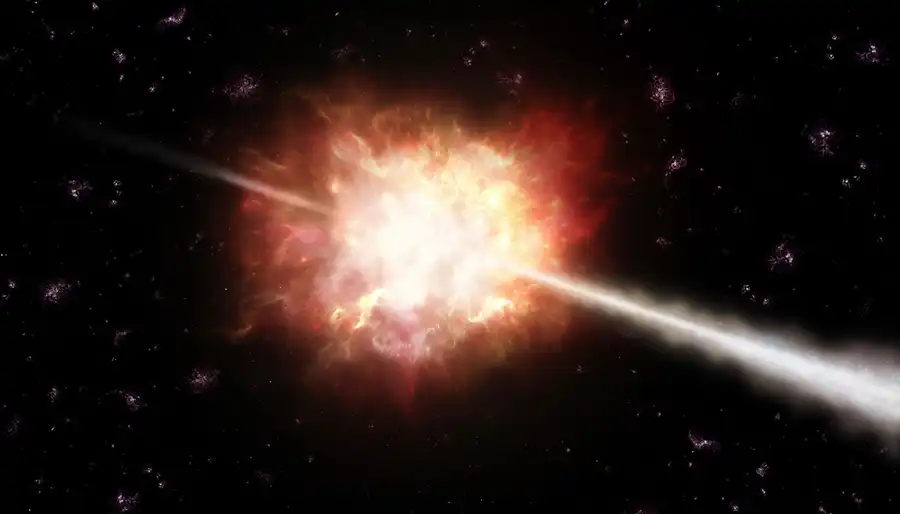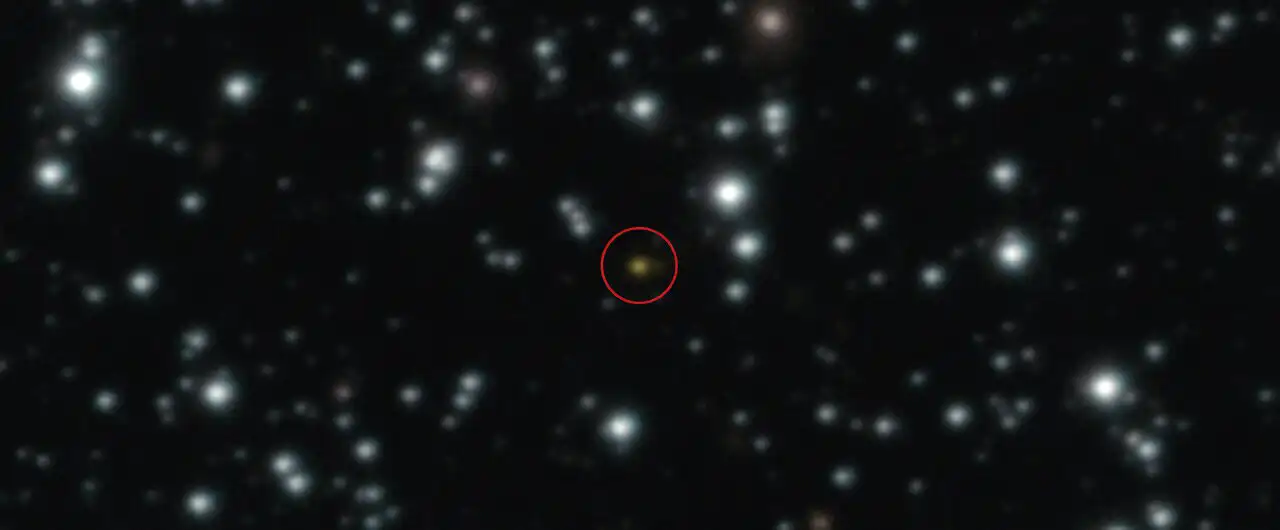
ESO / A. Roquette
Astronomers may have witnessed how a black hole ate its way into a star and blew it up from within. This exotic scenario looks like the best explanation for a most unusual gamma-ray burst.
The story began some 8 billion years ago, when an explosive event in a distant galaxy produced a tremendously bright burst of gamma-rays. On July 2, 2025, after traversing more than half of the observable universe, those high-energy photons reached Earth, triggering the gamma-ray detector onboard NASA’s Fermi space telescope.
Gamma-ray bursts (GRBs) are observed about once per day. Short ones, with a duration of less than 2 seconds or so, are caused by colliding neutron stars. Longer gamma-ray bursts are the result of collapsars — massive, fast-spinning stars that collapse into a black hole at the end of their brief lives, blasting particle jets into space.
But while long bursts usually last for a few minutes, GRB 250702B remained active for an unprecedented 7 hours, several times fading a bit only to brighten again. What’s more: The Chinese-European Einstein Probe already registered soft X-rays from the same source about a day before the onset of the gamma-ray burst — something that’s never been seen before. “It was certainly a very exceptional event,” says high-energy astrophysicist Ralph Wijers (University of Amsterdam).
A team led by Andrew Levan (Radboud University, The Netherlands) used the European Very Large Telescope in Chile to detect a near-infrared afterglow, and images from the Hubble Space Telescope pinpointed the burst’s location to the outskirts of a very faint galaxy, close to the border between the constellations Aquila and Scutum.

ESO / A. Levan / A. Martin-Carrillo et al.
In a rapidly produced paper that was published September 1st in Astrophysical Journal Letters, Levan and his colleagues argued that the ultra-long burst might have been produced when a white dwarf star was tidally disrupted by an intermediate-mass black hole, although they couldn’t rule out an unusual collapsar.
However, as more data from observatories all over the world (and in space) came in, it became clear that GRB 250702B was probably a much weirder event. For starters, a team led by Benjamin Gompertz (University of Birmingham, UK) used the James Webb Space Telescope to observe the burst’s host in more detail. It turned out to be a massive, asymmetric, and dusty galaxy. They also used Webb to measure the galaxy’s redshift and found that its light had traveled through expanding space for some 8 billion years before reaching Earth. This means that the gamma-ray burst must have been extremely luminous to be so bright despite its distance.
In mid-September, several papers by many dozens of authors appeared on the astronomical preprint server arXiv, describing infrared, X-ray, and radio observations of the afterglow. Some of these results were also presented at the poster session of the 22nd meeting of the High Energy Astrophysics Division (HEAD) of the American Astronomical Society in St. Louis.
The various groups agree that the afterglow observations can best be explained by powerful shock waves, generated by extremely narrow and fast-moving particle jets. But the extremely long duration of the burst, the very rapid (sub-second) gamma-ray variability, and the X-ray precursor emission are “incompatible with all confirmed gamma-ray burst progenitors and nearly all models in the literature,” according to a team led by Eliza Neights (George Washington University).
Instead, Neights and her colleagues suggest that GRB 250702B is the result of a unique merger. In their scenario, a bloated, evolved helium star orbits with a much smaller stellar-mass black hole. As the star continues to expand beyond the black hole’s orbit, the black hole consumes more and more material, slowing down the black hole and producing X-rays in the process. Eventually, the black hole eats its way into the very core of the disintegrating star, spouting jets that blow the stellar remains to smithereens from within.
At the HEAD meeting, Neights and her coauthor Eric Burns (Louisiana State University) declined to comment on their work, pending the publication of a NASA press release on the results, which will be accompanied by spectacular animations. However, because of the government shutdown, it might be a while before the release comes out.
If the hypothesis of a black hole falling into a star is the correct explanation for the unusual behavior of GRB 250702B, it is the first example of a new but very rare gamma-ray burst progenitor system. “It makes sense to come up with a very unique explanation for a single, unique event,” says Wijers, who was not involved in studying this particular gamma-ray burst. “The challenge is to think of something that is very rare, but not impossible. The merger model seems to be cleverly conceived.”
source: skyandtelescope.org